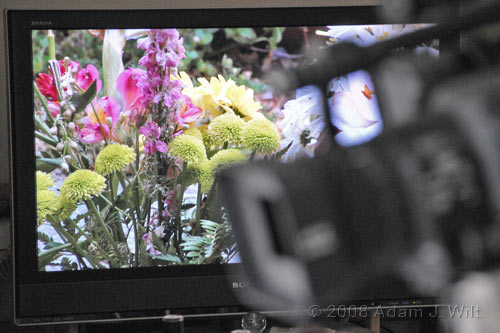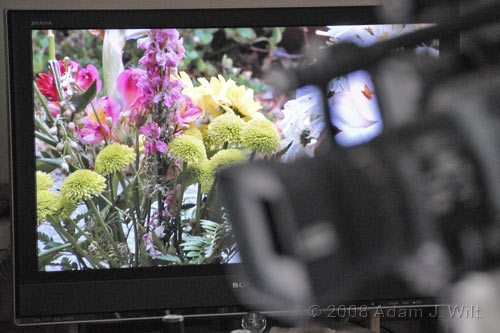
SD, 408p, 720p, 1080i, 1080p… 2k, 4k, UDTV… it seems like the big push is to get ever-higher resolution. It’s true that given two pictures, identical in every other way, that the higher-res image will look better—if you’re close enough to see the difference. But it turns out that resolution isn’t as important as you might think.
- In an internal technical paper written for ABC, Randy Hoffner said:
A typical study assigns the following weights to brightness, contrast, and resolution:
Contrast 64%
Resolution 21%
Brightness 15%
Resolution, then, is only a factor, and not the largest factor, in the determination of the subjective quality of a television picture.
[I asked Mr. Hoffner if he could dig up that study, but he wasn’t able to (his paper was written several years ago while he was at ABC; he’s since moved on to greener pastures—presumably contrastier, brighter, and higher-resolution ones); however, I’ve seen various other reports that come to similar conclusions.]
- For many people, upscaled SD (at least progressive 480p24, as on DVDs) looks just fine, with multiple reports (here, and here, and here, to link a few) saying that folks are happy enough with upconverted SD DVDs that they aren’t buying Blu-Ray (admittedly, cost is an issue too). I know from my own experience that a good unconverter makes proscan SD DVDs look amazing: several times I’ve had to get close to the screen to look for aliasing on fine detail to see whether Netflix sent us an HD-DVD instead of a standard-def DVD.
- Unless you’re sitting close to the screen, higher resolution doesn’t buy you much. Carlton Bale ran the numbers to show that unless you’re sitting within 12 feet of a 40″ screen, 480p is all the detail you need; you don’t see all 720p has to offer unless you’re within 8 feet of the screen; and you won’t see the full benefit of 1080p unless you’re within 5 feet (in other words, your feet will touch the TV if you’re lounging in front of it!). From my own tests with a 40″ screen, I can vouch for the veracity of his calculations.
- HDTVs are getting smaller, not larger, both as the economy declines and as reality sets in: big screens are big as well as pricey, and let’s face it, interlaced SD writ large on the big screen really shows its limits. As the novelty of bigness wears off, people may opt for smaller, more room-friendly sets, especially for second and third TVs.
I recently had the opportunity to test “the resolution question” myself. My wife underwent surgery, resulting in two things: long periods of seated immobility, and multiple deliveries of flowers. We set up a workstation for her in the living room, about seven feet from the 40″ LCD HDTV, but the workstation didn’t have room for the vases of flowers, and she couldn’t turn her head to see the flowers elsewhere.
I put the flowers outside on the patio and set up a camera. I could provide close-ups of the flowers (as in the image above), or go wide to shoot birds in the birdbath and in the garden. These pix were fed to the 40″ LCD, so my wife could enjoy the view while ensconced in a comfy chair.
I used different cameras at different times: a Sony HVR-Z1 (960×1080 native resolution), a Panasonic AG-HVX200 (960×540), and a Sony PMW-EX1 (1920×1080). All cameras fed the monitor 16×9 1080i analog component, with detail and color levels roughly matched.
From seven feet back, all the cameras were essentially identical in apparent sharpness.
If I moved my chair much closer (or got up and ogled the screen from a few inches away), I could see the difference, but even there, if I looked at the content, not just the fine detail, all the cameras were just fine. I was able to notice the differences when I switched between cameras, but when I walked into the room or turned on the first camera of the day, all I saw was a nice, HD picture of flowers (or birds). My wife (a graphic artist and video editor, among other things) noticed color and highlight-handling differences, but never commented on sharpness. Without an A/B comparison, our eyes were quite happy to accept what they saw as “true HD”.
What counted more than resolution was smoothness: all the cameras put out a fairly creditable 1080i signal, so even if a camera didn’t have a lot of native detail, its signal was smoothly continuous, without telltale 480i interlacing artifacts. The absence of jaggies, stairstepping, and the like “sold” the image even when high-frequency detail was lacking.
How often does telling the story require ultimate sharpness?
Yes, there are times when “too much is never enough”: when you’re projecting on a cinema screen; holding a long shot and letting the action play out in depth; intercutting with other material shot at a higher resolution (thus making the difference noticeable). 2001: A Space Odyssey requires high resolution. Its 2.2:1 aspect ratio, letterboxed in standard def, is barely watchable, but with HD-DVD or Blu-Ray playback (or 70mm theater projection) the detail-centric glory of Kubrick’s intricate vision becomes clear. “2001” is notable for its dependence on (a) a big screen, and (b) the extended long shot (consider also the iconic opening scene in “Star Wars – Episode IV”).
But sometimes, “too much is too much.” Few stories are played in long shots the way 2001 was; in human-centered dramas, the emphasis is on the close-up. Filmmakers have been putting nets on (or behind) their pin-sharp lenses for the better part of a century, or using any of a staggering variety of softening filters, to tone down and excess of nagging detail. The Saddest Music in the World was shot on Super16mm, 16mm (spring-wound Bolexes), and a raft of Bauer Super8mm cameras, most of them with Vaseline smeared on their lenses.
OK, “Saddest Music” is an extreme case, but even so: if it were all about resolution, then neither VHS nor YouTube would ever have succeeded.
The whole point of this rant (what, there’s a point?) is simply: don’t obsess about limiting resolution, it’s only one, small part of what makes pictures look good. Colorimetry, highlight handling, shadow detail, and motion rendering may not be as easy to measure, but they’re all more important to image quality.

